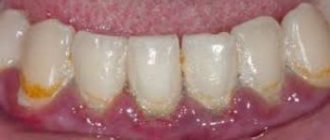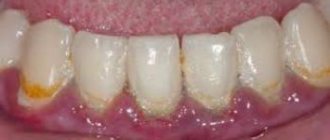Author of the article:
Soldatova Lyudmila Nikolaevna
Candidate of Medical Sciences, Professor of the Department of Clinical Dentistry of the St. Petersburg Medical and Social Institute, Chief Physician of the Alfa-Dent Dental Clinic, St. Petersburg
Everyone wants to have straight white teeth. A beautiful smile is not only a symbol of health. This is the key to self-confidence, one of the key factors in successful and fruitful communication. Is it worth mentioning that the white-toothed handsome man smiling at you in the reflection in the mirror every morning gives you an excellent mood for the whole day?
But what to do if plaque stubbornly appears on even teeth every morning? Can two cups of coffee during the day and a couple of packs of cigarettes put an end to a beautiful snow-white smile? Let's try to figure out why plaque appears on the teeth of adults, how to avoid it and how to deal with it.
Why is it important to remove tartar in a timely manner?
Hard plaque has many pores in which bacteria appear. Traces of the vital activity of these bacteria make the enamel softer. Therefore, when the enamel comes into contact with solid food, microcracks may appear, and subsequently caries.
In addition, when there is too much stone, it begins to put pressure on the gums. This may cause bleeding and inflammation.
Therefore, in order to remove tartar, it is important not only to brush your teeth regularly and thoroughly. The fact is that brushing your teeth only slows down the process of stone formation. But over time it will appear anyway.
To get rid of tartar, a special procedure is needed, and it needs to be repeated from time to time, depending on the rate of plaque growth (in each case individually). It is important to do this manipulation in a timely manner.
Causes and prevention
The best way to get rid of such an unpleasant phenomenon is to prevent it in time, and for this you need to find out how it appears.
The most common reason why black plaque appears on teeth is lack of hygiene. If you don’t brush your teeth regularly, don’t remove dirt from hard-to-reach areas and neglect procedures, plaque formation is inevitable.
The remaining “unattended” bacteria accumulate in the oral cavity, first on the inside of the dental units, in the cervical area, then move to the front walls, harden, turning into tartar, and darken over time. This is why black plaque on your teeth cannot simply be removed with toothpaste or a hard brush.
At the same time, pathogenic microorganisms can penetrate deep into the tooth structure, affect the pulp and root, and cause caries, periodontal disease, gingivitis and other pathologies. For prevention, it is recommended to undergo hygienic cleaning at the dentist regularly (once every six months).
Products containing caffeine and nicotine also cause black plaque to appear on teeth. They provoke the formation of pigment plaque, change the color of the enamel, and it is quite difficult to get rid of it.
To restore the whiteness of your teeth, you will most likely have to resort to a whitening procedure.
The greatest discomfort is caused by dark plaque on the front teeth in the smile area. And the presence of bacterial deposits or stone on the enamel accelerates and intensifies the darkening process.
Other reasons include:
- excessive consumption of foods high in iron;
- use of rinses containing phenols;
- metabolic disease;
- diseases of the digestive tract;
- hormonal disbalance;
- diabetes;
- bacterial diseases of the body;
- taking certain medications;
- regular toxic exposure to metals.
If dark brown plaque on your teeth appears in the form of spots, this may be a symptom of carious lesions, in which case you should immediately consult a specialist.
How to get rid of tartar at home?
When the plaque is fresh and has not yet hardened strongly, you can try to clean it at home.
If you want to know how to remove tartar at home, we suggest you familiarize yourself with proven methods.
1. Brush your teeth with special abrasive pastes. The plaque will be cleared in those places where the brush reaches.
2. Use an electronic brush with a generator that produces an ultrasonic wave that destroys plaque.
3. Use a toothbrush with a rotating head. It is good because it reaches many hard-to-reach places.
Along with the listed methods, there are traditional medicine for those who want to know how to remove tartar at home. For this purpose, soda, radish and lemon juice and herbal decoctions are used. But these methods are questionable and ineffective.
Therefore, if you want to professionally remove tartar without any risk of harming yourself, you should only contact a dental clinic.
Dental clinic "ORTHODONTiYA" will qualitatively and professionally remove tartar from teeth
Our clinic employs professionals with extensive experience.
To completely remove the stone, we use mechanical and ultrasonic cleaning. The procedure is carried out painlessly and without significant discomfort. In addition, there is no harmful effect on tooth enamel.
If you want to know how to remove tartar, as well as more information about preventative measures, come see us for a free consultation. We are always happy to answer all your questions and make your teeth healthy and strong.
Clinical researches
Clinical studies have proven that regular use of professional toothpaste ASEPTA GENTLE WHITENING for a month allows you to lighten tooth enamel by 1.5 tones, increases anti-caries effectiveness by 3.4 times and increases enamel remineralization by 2.6 times.
Sources:
- Report on determining/confirming the preventive properties of toothpaste “ASEPTA PLUS” GENTLE WHITENING” Author: doctor-researcher A.A. Leontyev, head Department of Preventive Dentistry, Doctor of Medical Sciences, Professor S.B. Ulitovsky First St. Petersburg State Medical University named after. acad. I.P. Pavlova, Department of Preventive Dentistry
- Report on the determination/confirmation of the preventive properties of personal oral hygiene products “ASEPTA PLUS” Remineralization doctor-researcher A.A. Leontyev, head Department of Preventive Dentistry, Doctor of Medical Sciences, Professor S.B. Ulitovsky First St. Petersburg State Medical University named after. acad. I.P. Pavlova, Department of Preventive Dentistry
- Clinical studies of antisensitive toothpaste “Asepta Sensitive” (A.A. Leontyev, O.V. Kalinina, S.B. Ulitovsky) A.A. LEONTIEV, dentist O.V. KALININA, dentist S.B. ULITOVSKY, Doctor of Medical Sciences, Prof. Department of Therapeutic Dentistry, St. Petersburg State Medical University named after. acad. I.P. Pavlova
Comments
I had my teeth cleaned at the dentist for the first time in my life just a few months ago, and today I noticed that there was too much plaque again. How so??
Olga (02.09.2020 at 20:39) Reply to comment
- Dear Olga, the rate of plaque formation can be affected by the presence of chronic diseases, poor oral hygiene, smoking, consumption of “colored” foods and drinks, the presence of gingivitis and periodontitis. Sometimes the cause of the pathology is the unprofessionalism of the doctor, who poorly polished the surface of hard tissues at the final stage of cleaning. You should contact an experienced dental hygienist or dental therapist to understand the situation.
Editorial staff of the portal UltraSmile.ru (09/06/2020 at 09:15) Reply to comment
I have an “extended” tooth, but it has become darker than mine, the doctor explained that a change in color can occur over time. Is it possible, in addition to a crown, to achieve lightening of just such a tooth?
Mira (09.23.2020 at 07:15) Reply to comment
Tell me, if you have crowns in visible places and your own teeth, what is best to use for cleaning? That is, the listed products for home use are also suitable for cleaning crowns. Or is there something simpler for crowns, or vice versa more effective?
Inga (09.23.2020 at 09:00) Reply to comment
Tell me, which method of professional teeth cleaning is the safest and most gentle? And what is the most correct and effective method of home cleaning? I'm afraid of ruining the enamel.
Elena (09/23/2020 at 11:57 am) Reply to comment
We were surprised about the banana peel! I knew about fruit acids. I have increased sensitivity of all my teeth, because my gums have risen, if I express myself correctly, that is, the necks of my teeth have become slightly open. Visually it’s not very noticeable, but there is a reaction to sweet/sour. In my case, there’s probably no way to whiten my teeth at all? Thank you.
Victoria (09/23/2020 at 12:32 pm) Reply to comment
Twice a year I do ultrasonic teeth cleaning. The dentist advised me to buy an electric ultrasonic toothbrush. But I heard that electric brushes destroy teeth. Is it worth buying?
Zlata (11/20/2020 at 6:10 pm) Reply to comment
Hello, can you tell me how often I can do water-abrasive cleaning? If six months have not yet passed since the last procedure, and I am still not satisfied with the cleanliness of my teeth, can I repeat the procedure, or will frequent use harm my teeth?
Irina (11/20/2020 at 6:59 pm) Reply to comment
Doesn’t all this cleaning harm the enamel and make the teeth, although plaque-free, sensitive? I'm afraid to even do regular brushing; I think I could damage my teeth or wear away the enamel.
Sveta (11/20/2020 at 07:41 pm) Reply to comment
I don't smoke, but I still have plaque. I drink a lot of coffee, so they are yellow. I used to brush with baking soda instead of tooth powder. Then they told me that I shouldn’t do this often because it could erase the enamel.
Anna (11/20/2020 at 08:29 pm) Reply to comment
A high-quality paste will help you and it’s expensive, and after one brushing I also clean it with tooth powder. Those. twice a morning, for example. Well, you also don’t need to overdo it with cleaning, so that you don’t have a dry mouth later.
Marina (11/20/2020 at 09:08 pm) Reply to comment
Write your comment Cancel reply
Can an irrigator replace dental floss?
The irrigator replaces dental floss in the following cases:
- Availability of orthodontic structures (braces, dentures, crowns). In this case, the use of dental floss can lead to a decrease in the functionality of the installed structure.
- Increased bleeding and sensitivity of the gums. Improper use of dental floss can injure the gum surface and increase bleeding.
- The need for gum massage. In some cases, the doctor may recommend the use of an irrigator as an auxiliary therapeutic agent.
In addition to the above, an additional advantage when the irrigator replaces dental floss is: the ability to select the most suitable mode and the nozzle required in a particular case.
Laser
Removal using laser. This method is gentle and allows you to preserve the enamel. The procedure is painless and does not harm the enamel. For example, when sandblasting your teeth, your gums may begin to bleed, but a laser will save you from this unpleasant moment.
NOTE: not every clinic provides such a service, and its cost cannot be called low. The price for laser therapy starts from 3 thousand rubles. in one session.
The photo shows laser deep cleaning of stones and plaque
Professional Air Flow cleaning
This method is considered the most gentle on enamel and painless. The essence of the procedure is to influence deposits with a mixture of water, air and soda crystals, which is supplied under pressure. This way you can clean your teeth and the spaces between them.
The dentist recommends Air Flow cleaning to the patient in the following cases:
- the presence of plaque that turns into stone;
- discoloration of enamel caused by drinking strong tea, coffee, carbonated drinks, smoking;
- if it is necessary to install or remove crowns, braces, implants, high-quality cleaning of these systems;
- the presence of tightly spaced, twisted teeth in a row;
- the appearance of symptoms of periodontal disease.
Timely cleaning with such a device helps prevent the development of caries, gingivitis, periodontitis and periodontal disease. It allows you to effectively remove deposits on teeth, between units, even in the most inaccessible places, as well as on dental structures. At the same time, the enamel becomes lighter by 1-2 tones, pigment spots disappear. During polishing, the enamel is saturated with fluoride and strengthened.
Despite all the advantages of Air Flow, this procedure has a number of contraindications. In particular, it is not carried out when:
- severe pathologies of the respiratory system, including bronchial asthma;
- hepatitis;
- diabetes mellitus;
- tuberculosis;
- tendency to allergic reactions;
- HIV;
- infectious diseases;
- heart rhythm disturbances, presence of a pacemaker;
- increased sensitivity of enamel;
- the presence of areas of demineralization;
- installed titanium implants.
This method of professional cleaning is not recommended during pregnancy and lactation.
After the procedure, for 2-3 days the patient may complain of pain when eating cold and hot food. To reduce enamel sensitivity, you must use toothpaste labeled “Sensitive.” Be sure to buy a new brush with soft bristles.
During this period, it is better to exclude sour and sweet foods, cold and hot foods from the diet, refuse to drink carbonated drinks with dyes (including low-alcohol ones), coffee, strong black tea, and red wine. It is undesirable to eat red and orange fruits and vegetables.
How to floss
- A part with a length of 20 to 30 centimeters is separated from the total skein.
- A piece of thread is fixed between the fingers of two hands.
- The stretched thread is inserted between the teeth and lowered with smooth movements to the gums.
- Keeping the floss taut, make forward and backward movements.
- Each new gap requires the use of a new section of thread.
Having examined both oral care products in detail, we can draw conclusions about whether an irrigator can replace dental floss .
Possible complications
Of course, with brown layers there is no need to talk about aesthetics. This is an important aspect, but not the main one. Deposits must be removed before they cause serious oral ailments. When the enamel turns black, an irreversible problem develops, such as gingival bleeding caused by plaque around the gums, or tartar, periodontitis or gingivitis, complete destruction of the enamel and increased sensitivity of the units. When the first signs of darkening appear, you should immediately consult a doctor. Do not ignore the disease, as it may indicate diseases of the internal organs.
In such a situation, the patient is referred for consultation to a gastroenterologist, endocrinologist or infectious disease specialist. After receiving information from specialists, the dentist develops a program to restore the color of the affected units and remove plaque between the teeth. If tuberculosis or diabetes mellitus, allergies or parasite infection, gallbladder dyskinesia or other serious ailments are diagnosed, the dentist begins work after treating them.
Dark plaque in children
In children, dark plaque on teeth can be caused by the following factors:
- chromogenic bacteria that produce pigments;
- diseases – dysbacteriosis, disruption of the digestive system;
- change of diet and usual products;
- hereditary predisposition;
- lack of calcium during fetal development and in the first months after birth;
- disruptions in the functioning of the immune system;
- dysfunction of the salivary glands;
- enamel hypoplasia and caries.
The cause of black plaque on a child’s teeth may be the so-called Priestley’s plaque. It occurs even on baby teeth and can appear at any age - both in teenagers and in very young children. Accompanied by an unpleasant odor from the mouth.
This phenomenon is a product of the vital activity of certain bacteria - a black pigment that settles on the enamel. It is safe for molars and for the body as a whole, does not provoke the development of pathologies and goes away on its own over time.
If we talk about how to remove dark plaque from a child’s teeth, professional hygienic cleaning will help, but it is not a guarantee that it will not appear again soon.
Blackening of the wisdom tooth
It is not uncommon for patients to come to the clinic with a similar complaint. As a rule, “eights” erupt with problems and with severe pain, and besides, they appear already spoiled. Often, such teeth are simply removed, since they do not bear any load when chewing, and also do not affect aesthetics.
Treatment, of course, can be carried out, but it will be labor-intensive and in most cases useless. It will still need to be removed. We advise you to think carefully before starting treatment.
Reasons for the formation of black plaque
- Excessive smoking and coffee consumption. This reason is the most common . The substances contained have coloring properties. Penetrating into plaque, it darkens, hardens and almost attaches to the enamel, thereby forming tartar.
Nicotine resins, tea and coffee pigments provoke the rapid formation of such plaque, which is then quite difficult to clean.
- As a result of a serious illness or taking antibiotics over a long period of time. For example, black plaque occurs with problems with the liver, spleen, complications of viral infections.
- Work specifics. Blackening of teeth in the gum area is observed among workers in the metallurgical industry. This is due to the formation of condensate, which contains microparticles of heavy metals, which, when inhaled, deposit on the internal organs. This leads to poisoning, what can we say about the usual staining of plaque.
- In children, dysbacteriosis can provoke the appearance of plaque. A child's intestinal microflora is formed before the age of three. Therefore, there is no need to fall into a state of panic and enthusiastically begin to remove plaque from your teeth. Basically, the plaque disappears on its own after some time.
- Consumption of apples is a controversial issue. For the whole body and enamel in particular, it is useful to eat a couple of apples a day.
NOTE: when it’s out of season, fruits in the store are treated with harmful chemicals to ensure their safety. Thus, when you eat a large number of apples, you consume a large dose of formaldehyde and other harmful substances. In this case, do not be surprised that you have a black coating.
- Addiction. A destructive process occurs in all internal organs, including teeth. With this option, you can say goodbye to a healthy and beautiful smile.
Kinds
Stationary
The power of the supplied jet usually does not exceed 550 kPa. The most preferred pulsation frequency does not exceed 1200 pulsating emissions. The device is mounted on a wall or any horizontal surface.
Portable
Completely autonomous, battery-powered devices with a jet power of at least 520 kPa. As a rule, they have the possibility of stepwise adjustment of modes.
Flow irrigators
A fairly democratic and simple device that changes power using a mixer valve.
Mechanical irrigators
The intensity of the supplied jet is set by pumping up the pump by hand.









